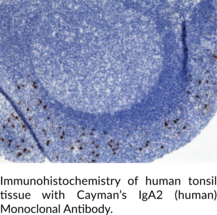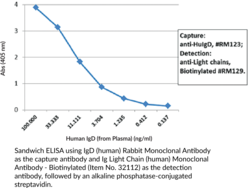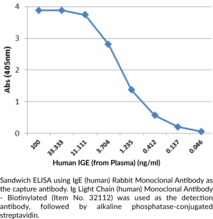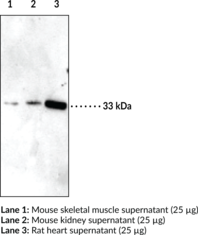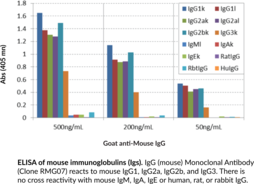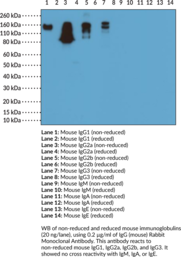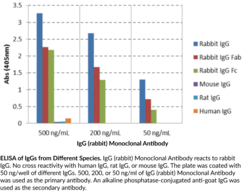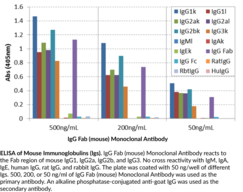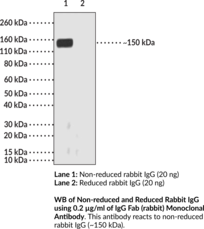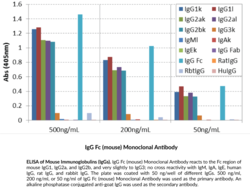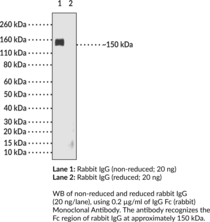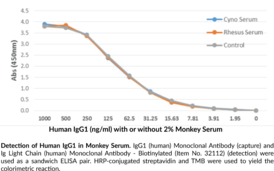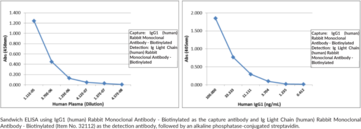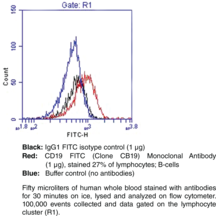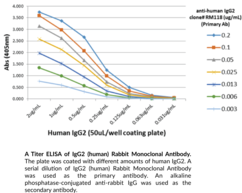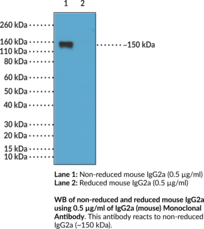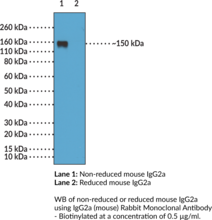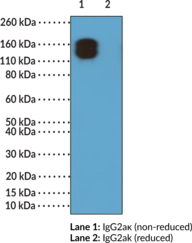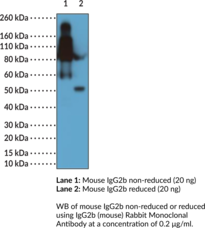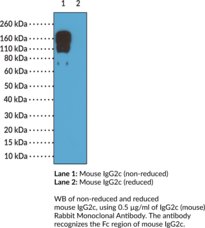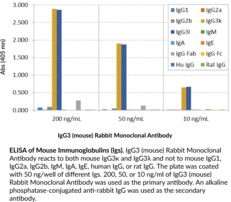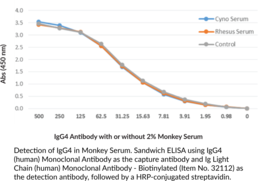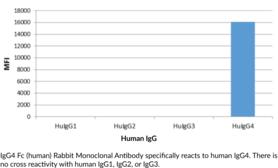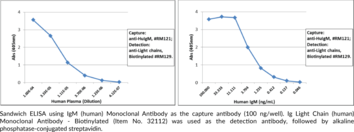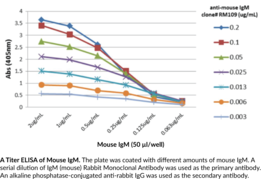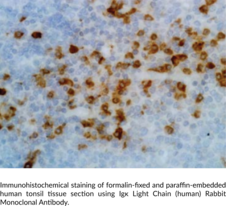Cayman
Showing 24601–24750 of 45550 results
-
Immunoglobulin A (IgA) is a member of the immunoglobulin superfamily of glycoproteins with roles in host defense against intestinal pathogens and both quantitative and qualitative control of host commensal microbiota composition.{53918,53919} Human IgA consists of two identical light chains of approximately 25 kDa each, as well as two heavy chains of approximately 60 kDa each that contain C-terminal extensions, known as tailpieces, which allow for IgA oligomerization.{53927,53925} There are two IgA subclasses, IgA1 and IgA2, which are encoded by IGHA1/α1 and IGHA2/α2, respectively, and have differences primarily in the hinge and heavy chain constant regions.{53925} IgA is produced by B cells and later secreted by plasma cells and is the most abundant antibody on mucosal surfaces that comprises at least 70% of all Ig produced in mice.{53918,53919} Monomeric IgA1 is predominant in the serum, but dimeric secretory IgA (SIgA) is the predominant form in mucosal surfaces and secretions with the ratio of subclasses varying based on the IgA-secreting cell types present.{53925,53921} Dimeric and polymeric IgA bind to Igα Fc receptor I (FcαRI) and the IgM- and IgA-binding high affinity Igα and Igµ Fc receptor (Fcα/µ-R), which are both involved in mediating immune responses.{53921,53922} Production of IgA is induced in the gut only in animals containing intestinal microbes, and the number of IgA-producing plasma cells is reduced in germ-free mice.{53918} IgA levels are increased in certain gastrointestinal tract and liver diseases, with IgA2 levels increased to a higher degree than IgA1 levels in patients with Crohn’s disease and alcoholic liver disease.{56183} Cayman’s IgA2 (human) Monoclonal Antibody can be used for ELISA, immunocytochemistry (ICC), and immunohistochemistry (IHC) applications.
Brand:CaymanSKU:32116 - 100 µgAvailable on backorder
Immunogen: Human IgA2 • Host: Rabbit • Species Reactivity: (+) Human • Cross Reactivity: (+) Human IgA2 (-) Human IgA1, IgG, IgM, IgD, IgE • Applications: ELISA, ICC, IHC
Brand:CaymanSKU:32116- 100 µgAvailable on backorder
Immunogen: Human IgD • Host: Rabbit • Species Reactivity: (+) Human • Cross Reactivity: (+) IgD; (-) Human IgG, IgM, IgA, IgE • Applications: ELISA
Brand:CaymanSKU:32117- 100 µgImmunoglobulin D (IgD) is a member of the immunoglobulin superfamily of glycoproteins that functions as a B cell antigen receptor (BCR) and has roles in adaptive immunity.{52717} Human IgD is composed of two Igδ heavy chains of approximately 50 kDa each and two Igĸ or Igλ light chains of approximately 25 kDa each.{52718,28520} It is expressed on the surface of antigen-naïve mature B cells, which are found in germinal centers and peripheral blood, as well as certain subsets of circulating memory B cells.{52717,52719} IgD levels increase during B cell maturation and are regulated by alternative splicing of an mRNA transcript that is common to the µ and δ heavy chains of IgM and IgD, respectively.{52717,52720} Upon antigen activation, IgD can undergo class switch recombination to the immunoglobulin isotypes IgA, IgE, or IgG, each of which has a distinct effector function.{52721} IgD can also be produced from IgM by class switch recombination, leading to the generation of IgD-secreting plasma cells that have roles in mucosal immunity.{52722} IgD binds to basophil and mast cell lines, as well as the respiratory pathogens M. catarrhalis and H. influenzae, in vitro.{52723} Serum IgD levels are increased in patients with a variety of conditions, including leprosy, tuberculosis, malaria, or Hodgkin’s lymphoma and is a hallmark of hyperimmunoglobulinemia D syndrome (HIDS), an autoinflammatory condition characterized by febrile episodes.{52724} Cayman’s IgD (human) Rabbit Monoclonal Antibody can be used for ELISA.
Brand:CaymanSKU:32117 - 100 µgAvailable on backorder
Immunogen: Human IgD • Host: Rabbit • Species Reactivity: (+) Human • Cross Reactivity: (+) IgD; (-) Human IgG, IgM, IgA, IgE • Applications: ELISA
Brand:CaymanSKU:32117- 100 µgAvailable on backorder
Immunogen: Human IgE • Host: Rabbit • Species Reactivity: (+) Human • Cross Reactivity: (+) Human IgE; (-) Human IgG, IgA, IgD, IgM • Applications: ELISA
Brand:CaymanSKU:32118- 100 µgImmunoglobulin E (IgE) is a member of the immunoglobulin superfamily of glycoproteins that plays a central role in type I hypersensitivity reactions and the immune response to parasites.{28520,54323,54324} It is synthesized by B cells and later secreted by plasma cells and is the least abundant circulating antibody in human serum.{28520,54323} IgE consists of two light chains and two heavy chains, or ε chains, that contain one variable region and four Ig-like constant domains Cε1-Cε4, but lacks the flexible hinge region seen in IgD, IgG, and IgA.{54324,54325} The heavy chains are linked together by disulfide bonds to form an Fc region and also combine with the light chains to form the Fab region, which mediate receptor and antigen binding, respectively.{55171} IgE binds to type I Fcε receptors (FcεRIs) on the surface of mast cells, basophils, and antigen-presenting dendritic cells.{54323} Multivalent antigen binding to IgE on the surface of mast cells induces IgE crosslinking and mast cell degranulation to initiate type I hypersensitivity reactions, including, but not limited to, systemic anaphylaxis, wheal and flare responses, allergic rhinitis, bronchial asthma, and food allergies. Serum levels of IgE are elevated in response to parasitic infection and IgE directly binds parasites to target the parasite for eosinophil degranulation-induced destruction. Cayman’s IgE (human) Rabbit Monoclonal Antibody can be used for ELISA.
Brand:CaymanSKU:32118 - 100 µgAvailable on backorder
Immunogen: Human IgE • Host: Rabbit • Species Reactivity: (+) Human • Cross Reactivity: (+) Human IgE; (-) Human IgG, IgA, IgD, IgM • Applications: ELISA
Brand:CaymanSKU:32118- 100 µgAvailable on backorder
Insulin-like growth factor binding protein 5 (IGFBP5) is a secreted protein that binds IGF-1 and restricts it from accessing its cell-surface receptor (IGF-1R). This aids in regulation of cell growth, differentiation, and apoptosis.{14904} IGFBP5 also displays IGF-1 independent transactivational activity in the nucleus.{14903} Some tissues and cell types with higher levels of this protein include kidney, heart, placenta, and skeletal cells.{14902} Expression has also been reported in a variety of cancers, including mammary gland and neuroblastoma.{14904,14899} Cayman’s IGFBP5 Polyclonal Antibody is directed against a synthetic peptide sequence that partially overlaps the IGFBP5 region identified as a nuclear localization signal.{14903} IGFBP5 (272 amino acids) has a calculated molecular weight of 30.6 kDa. Cayman’s IGFBP5 Polyclonal Antibody can be used for Western blot applications and recognizes IGFBP5 at 33 kDa from mouse and rat samples. Reported glycosylation and phosphorylation sites may explain the band migration to 33 kDa.{14904,14901}
Brand:CaymanSKU:10008207 - 500 µlAvailable on backorder
Immunogen: Synthetic peptide from the internal region of human IGFBP5 • Host: Rabbit • Species Reactivity: (+) Mouse and rat • Application: WB • IGFBP5 is a secreted protein that binds IGF-1 and restricts it from accessing its cell-surface receptor (IGF-1R). This aids in regulation of cell growth, differentiation, and apoptosis.
Brand:CaymanSKU:10008207- 500 µlAvailable on backorder
Immunogen: Synthetic peptide from the internal region of human IGFBP5 • Host: Rabbit • Species Reactivity: (+) Mouse and rat • Application: WB • IGFBP5 is a secreted protein that binds IGF-1 and restricts it from accessing its cell-surface receptor (IGF-1R). This aids in regulation of cell growth, differentiation, and apoptosis.
Brand:CaymanSKU:10008207- 500 µlImmunogen: Mouse IgG • Host: Goat • Species Reactivity: (+) Mouse • Cross Reactivity: (+) Mouse IgG1, IgG2a, IgG2b, IgG3 (-) Mouse IgM, IgA, IgE (-) Human, rabbit, or rat IgG • Applications: ELISA, FC, IP • MW = None listed
Brand:CaymanSKU:22469- 100 µgAvailable on backorder
Immunogen: Mouse IgG • Host: Goat • Species Reactivity: (+) Mouse • Cross Reactivity: (+) Mouse IgG1, IgG2a, IgG2b, IgG3 (-) Mouse IgM, IgA, IgE (-) Human, rabbit, or rat IgG • Applications: ELISA, FC, IP • MW = None listed
Brand:CaymanSKU:22469- 100 µgImmunoglobulin G (IgG) is a member of the immunoglobulin superfamily of glycoproteins that plays a central role in the adaptive immune response.{28520} It is produced by B cells and later secreted by plasma cells and is the most abundant circulating antibody in human and mouse serum.{28520,55170,55174} IgG consists of two heavy chains of approximately 50 kDa each and two light chains of approximately 25 kDa each.{28520} The heavy chains are linked together by disulfide bonds to form an Fc region and also combine with the light chains to form the Fab region, which mediate receptor and antigen binding, respectively.{55171} IgG is produced following IgM class-switching in response to infection and is involved in numerous humoral host defense responses, including antibody-dependent cell-mediated cytotoxicity (ADCC), toxin neutralization, and pathogen opsonization.{55170} IgG exists as four isotypes in mice: IgG1, IgG2b, IgG3, and, in a strain-specific manner, IgG2a or IgG2c.{55172,53858} Formulations containing humanized, chimeric, or murine IgG monoclonal antibodies have been used in the treatment of inflammatory diseases, such as ulcerative colitis, rheumatoid arthritis, and asthma, as well as cancer.{55173} Cayman’s IgG (mouse) Monoclonal Antibody (Clone RMG07) can be used for ELISA, flow cytometry (FC), and immunoprecipitation (IP) applications. The antibody recognizes IgG from mouse samples.
Brand:CaymanSKU:22469 - 100 µgAvailable on backorder
Immunogen: Mouse IgG • Host: Rabbit • Species Reactivity: (+) Mouse • Cross Reactivity: (+) Goat IgG; (+) Mouse IgG1, IgG2a, IgG2b, IgG3; (-) Human, rat IgG; (-) Mouse IgA, IgE, IgM • Applications: ELISA, WB (non-reducing conditions)
Brand:CaymanSKU:32002- 100 µgImmunoglobulin G (IgG) is a member of the immunoglobulin superfamily of glycoproteins that plays a central role in the adaptive immune response.{28520} It is produced by B cells and later secreted by plasma cells and is the most abundant circulating antibody in human and mouse serum.{28520,55170,55174} IgG consists of two heavy chains of approximately 50 kDa each and two light chains of approximately 25 kDa each.{28520} The heavy chains are linked together by disulfide bonds to form an Fc region and also combine with the light chains to form the Fab region, which mediate receptor and antigen binding, respectively.{55171} IgG is produced following IgM class-switching in response to infection and is involved in numerous humoral host defense responses, including antibody-dependent cell-mediated cytotoxicity (ADCC), toxin neutralization, and pathogen opsonization.{55170} IgG exists as four isotypes in mice: IgG1, IgG2b, IgG3, and, in a strain-specific manner, IgG2a or IgG2c.{55172,53858} Formulations containing humanized, chimeric, or murine IgG monoclonal antibodies have been used in the treatment of inflammatory diseases, such as ulcerative colitis, rheumatoid arthritis, and asthma, as well as cancer.{55173} Cayman’s IgG (mouse) Rabbit Monoclonal Antibody can be used for ELISA and Western blot (WB; non-reducing conditions) applications. The antibody recognizes the Fc region of IgG from mouse samples.
Brand:CaymanSKU:32002 - 100 µgAvailable on backorder
Immunogen: Mouse IgG • Host: Rabbit • Species Reactivity: (+) Mouse • Cross Reactivity: (+) Goat IgG; (+) Mouse IgG1, IgG2a, IgG2b, IgG3; (-) Human, rat IgG; (-) Mouse IgA, IgE, IgM • Applications: ELISA, WB (non-reducing conditions)
Brand:CaymanSKU:32002- 100 µgAvailable on backorder
Immunogen: Rabbit IgG • Host: Goat • Species Reactivity: (+) Rabbit • Cross Reactivity: (-) Human, mouse, and rat IgG • Applications: ELISA, WB
Brand:CaymanSKU:32105- 100 µgImmunoglobulin G (IgG) is a member of the immunoglobulin superfamily of glycoproteins that plays a central role in the adaptive immune response.{53881,53882} It is produced by B cells and later secreted by plasma cells and is the most abundant circulating antibody in rabbit serum. IgG consists of two identical heavy chains of approximately 50 kDa each and two identical light chains of approximately 25 kDa each.{53881} The heavy chains are linked together by a single disulfide bond to form an Fc region and also combine with the light chains through additional disulfide bonds to form the Fab region, which mediate receptor and antigen binding, respectively. IgG is produced following IgM class-switching in response to infection and is involved in numerous humoral host defense responses, including antibody-dependent cell-mediated cytotoxicity (ADCC), toxin neutralization, and pathogen opsonization.{53881,55170,53883} Rabbits express three light chains, IgGκ (K1), IgGκ (K2), and IgGγ, with IgGκ (K1)-containing IgGs comprising approximately 90% of the total IgG population. Unlike human and mouse IgG, rabbit IgG has a single subclass and a short upper and middle hinge length of only 11 residues that facilitates the hinge extension necessary for binding of the Fc receptor (FcR) and activating complement component 1q (C1q) to facilitate complement activation.{53882,53880} Cayman’s IgG (rabbit) Monoclonal Antibody can be used for ELISA and Western blot (WB) applications.
Brand:CaymanSKU:32105 - 100 µgAvailable on backorder
Immunogen: Rabbit IgG • Host: Goat • Species Reactivity: (+) Rabbit • Cross Reactivity: (-) Human, mouse, and rat IgG • Applications: ELISA, WB
Brand:CaymanSKU:32105- 100 µgAvailable on backorder
Immunogen: Mouse IgG • Host: Goat • Species Reactivity: (+) Mouse • Cross Reactivity: (+) Mouse IgG1, IgG2a, IgG2b, IgG3; (-) Mouse IgM, IgA, IgE; (-) Human, rabbit, rat IgG • Applications: ELISA, FC, IP
Brand:CaymanSKU:21780- 100 µgAvailable on backorder
Immunogen: Mouse IgG • Host: Goat • Species Reactivity: (+) Mouse • Cross Reactivity: (+) Mouse IgG1, IgG2a, IgG2b, IgG3; (-) Mouse IgM, IgA, IgE; (-) Human, rabbit, rat IgG • Applications: ELISA, FC, IP
Brand:CaymanSKU:21780- 100 µgImmunoglobulin G (IgG) is a member of the immunoglobulin superfamily of glycoproteins that plays a central role in the adaptive immune response.{28520} It is produced by B cells and later secreted by plasma cells and is the most abundant circulating antibody in human and mouse serum.{28520,55170,55174} IgG consists of two heavy chains of approximately 50 kDa each and two light chains of approximately 25 kDa each.{28520} The heavy chains are linked together by disulfide bonds to form an Fc region and also combine with the light chains to form the Fab region, which mediate receptor and antigen binding, respectively.{55171} IgG is produced following IgM class-switching in response to infection and is involved in numerous humoral host defense responses, including antibody-dependent cell-mediated cytotoxicity (ADCC), toxin neutralization, and pathogen opsonization.{55170} IgG exists as four isotypes in mice: IgG1, IgG2b, IgG3, and, in a strain-specific manner, IgG2a or IgG2c.{55172,53858} Formulations containing humanized, chimeric, or murine IgG monoclonal antibodies have been used in the treatment of inflammatory diseases, such as ulcerative colitis, rheumatoid arthritis, and asthma, as well as cancer.{55173} Cayman’s IgG Fab (mouse) Monoclonal Antibody can be used for ELISA, flow cytometry (FC), and immunoprecipitation (IP) applications. The antibody recognizes the Fab region of IgG from mouse samples.
Brand:CaymanSKU:21780 - 100 µgAvailable on backorder
Immunogen: Rabbit IgG • Host: Goat • Species Reactivity: (+) Rabbit • Cross Reactivity: (-) Human, mouse, and rat IgG • Applications: ELISA, WB • MW: ~150 kDa for non-reduced IgG
Brand:CaymanSKU:32099- 100 µgImmunoglobulin G (IgG) is a member of the immunoglobulin superfamily of glycoproteins that plays a central role in the adaptive immune response.{53880,53881,53882} It is produced by B cells and later secreted by plasma cells and is the most abundant circulating antibody in rabbit serum. IgG consists of two identical heavy chains of approximately 50 kDa each and two identical light chains of approximately 25 kDa each.{53880,53881} The heavy chains are linked together by a single disulfide bond to form an Fc region and also combine with the light chains through additional disulfide bonds to form the Fab region, which mediate receptor and antigen binding, respectively. IgG is produced following IgM class-switching in response to infection and is involved in numerous humoral host defense responses, including antibody-dependent cell-mediated cytotoxicity (ADCC), toxin neutralization, and pathogen opsonization.{53880,53881,55170,53883} Rabbits express three light chains, IgGκ (K1), IgGκ (K2), and IgGγ, with IgGκ (K1)-containing IgGs comprising approximately 90% of the total IgG population. Unlike human and mouse IgG, rabbit IgG has a single subclass and a short upper and middle hinge length of only 11 residues that facilitates the hinge extension necessary for binding of the Fc receptor (FcR) and activating complement component 1q (C1q) to facilitate complement activation.{53880,53882} Cayman’s IgG Fab (rabbit) Monoclonal Antibody can be used for ELISA and Western blot (WB) applications. The antibody recognizes the Fab region of non-reduced IgG at approximately 150 kDa from rabbit samples.
Brand:CaymanSKU:32099 - 100 µgAvailable on backorder
Immunogen: Rabbit IgG • Host: Goat • Species Reactivity: (+) Rabbit • Cross Reactivity: (-) Human, mouse, and rat IgG • Applications: ELISA, WB • MW: ~150 kDa for non-reduced IgG
Brand:CaymanSKU:32099- 100 µgAvailable on backorder
Immunogen: Mouse IgG • Host: Goat • Species Reactivity: (+) Mouse • Cross Reactivity: (+) Mouse IgG1, IgG2a, IgG2b, IgG3 (weakly); (-) Human, rabbit, rat IgG; (-) Mouse IgA, IgE, IgM • Application: ELISA
Brand:CaymanSKU:32106- 100 µgImmunoglobulin G (IgG) is a member of the immunoglobulin superfamily of glycoproteins that plays a central role in the adaptive immune response.{28520} It is produced by B cells and later secreted by plasma cells and is the most abundant circulating antibody in human and mouse serum.{28520,55170,55174} IgG consists of two heavy chains of approximately 50 kDa each and two light chains of approximately 25 kDa each.{28520} The heavy chains are linked together by disulfide bonds to form an Fc region and also combine with the light chains to form the Fab region, which mediate receptor and antigen binding, respectively.{55171} IgG is produced following IgM class-switching in response to infection and is involved in numerous humoral host defense responses, including antibody-dependent cell-mediated cytotoxicity (ADCC), toxin neutralization, and pathogen opsonization.{55170} IgG exists as four isotypes in mice: IgG1, IgG2b, IgG3, and, in a strain-specific manner, IgG2a or IgG2c.{55172,53858} Formulations containing humanized, chimeric, or murine IgG monoclonal antibodies have been used in the treatment of inflammatory diseases, such as ulcerative colitis, rheumatoid arthritis, and asthma, as well as cancer.{55173} Cayman’s IgG Fc (mouse) Monoclonal Antibody can be used for ELISA. The antibody recognizes the Fc region of IgG from mouse samples.
Brand:CaymanSKU:32106 - 100 µgAvailable on backorder
Immunogen: Mouse IgG • Host: Goat • Species Reactivity: (+) Mouse • Cross Reactivity: (+) Mouse IgG1, IgG2a, IgG2b, IgG3 (weakly); (-) Human, rabbit, rat IgG; (-) Mouse IgA, IgE, IgM • Application: ELISA
Brand:CaymanSKU:32106- 100 µgAvailable on backorder
Immunogen: Rabbit IgG • Host: Goat • Species Reactivity: (+) Rabbit • Cross Reactivity: (-) Human, mouse, rat IgG • Applications: ELISA, WB (non-reducing conditions) • MW: ~150 kDa
Brand:CaymanSKU:32104- 100 µgImmunoglobulin G (IgG) is a member of the immunoglobulin superfamily of glycoproteins that plays a central role in the adaptive immune response.{53881,53882} It is produced by B cells and later secreted by plasma cells and is the most abundant circulating antibody in rabbit serum. IgG consists of two identical heavy chains of approximately 50 kDa each and two identical light chains of approximately 25 kDa each.{53881} The heavy chains are linked together by a single disulfide bond to form an Fc region and also combine with the light chains through additional disulfide bonds to form the Fab region, which mediate receptor and antigen binding, respectively. IgG is produced following IgM class-switching in response to infection and is involved in numerous humoral host defense responses, including antibody-dependent cell-mediated cytotoxicity (ADCC), toxin neutralization, and pathogen opsonization.{55170,53881,53883} Rabbits express three light chains, IgGκ (K1), IgGκ (K2), and IgGγ, with IgGκ (K1)-containing IgGs comprising approximately 90% of the total IgG population. Unlike human and mouse IgG, rabbit IgG has a single subclass and a short upper and middle hinge length of only 11 residues that facilitates the hinge extension necessary for binding of the Fc receptor (FcR) and activating complement component 1q (C1q) to facilitate complement activation.{53882,53880} Cayman’s IgG Fc (rabbit) Monoclonal Antibody can be used for ELISA and Western blot (WB; non-reducing conditions) applications. The antibody recognizes the Fc region of IgG at approximately 150 kDa from rabbit samples.
Brand:CaymanSKU:32104 - 100 µgAvailable on backorder
Immunogen: Rabbit IgG • Host: Goat • Species Reactivity: (+) Rabbit • Cross Reactivity: (-) Human, mouse, rat IgG • Applications: ELISA, WB (non-reducing conditions) • MW: ~150 kDa
Brand:CaymanSKU:32104- 100 µgAvailable on backorder
Brand:CaymanSKU:400914 - 1 eaAvailable on backorder
Immunogen: Peptide corresponding to the hinge region of human IgG1 • Host: Rabbit • Species Reactivity: (+) Human • Cross Reactivity: (-) Human IgG2, IgG3, IgG4, IgM, IgA, IgD, IgE; (-) Cynomolgus monkey, goat, mouse, rat, or rhesus monkey IgG • Applications: ELISA, ICC, IHC
Brand:CaymanSKU:32119- 100 µgImmunoglobulin G (IgG) is a member of the immunoglobulin superfamily of glycoproteins that plays a central role in the adaptive immune response.{28520} It is produced by B cells and later secreted by plasma cells and is the most abundant circulating antibody in human and mouse serum.{28520,55170,55174} IgG consists of two heavy chains of approximately 50 kDa each and two light chains of approximately 25 kDa each.{28520} The heavy chains are linked together by disulfide bonds to form an Fc region and also combine with the light chains to form the Fab region, which mediate receptor and antigen binding, respectively.{55171} IgG is produced following IgM class-switching in response to infection and is involved in numerous humoral host defense responses, including antibody-dependent cell-mediated cytotoxicity (ADCC), toxin neutralization, and pathogen opsonization.{55170} IgG exists as four isotypes in humans, IgG1, IgG2, IgG3, and IgG4, each of which has a distinct effector function. IgG1 binds to Fc receptors to induce Fc receptor-mediated effector functions, as well as Cq1 to induce complement activation in response to soluble and membrane protein antigens. Maternal IgG1s are shared with the fetus via placental transfer and children with group B streptococcal-induced sepsis are born to mothers with decreased serum levels of IgG1 compared with mothers of uninfected children.{53928} Cayman’s IgG1 (human) Monoclonal Antibody can be used for ELISA, immunocytochemistry (ICC), and immunohistochemistry (IHC) applications.
Brand:CaymanSKU:32119 - 100 µgAvailable on backorder
Immunogen: Peptide corresponding to the hinge region of human IgG1 • Host: Rabbit • Species Reactivity: (+) Human • Cross Reactivity: (-) Human IgG2, IgG3, IgG4, IgM, IgA, IgD, IgE; (-) Cynomolgus monkey, goat, mouse, rat, or rhesus monkey IgG • Applications: ELISA, ICC, IHC
Brand:CaymanSKU:32119- 100 µgAvailable on backorder
Immunoglobulin G (IgG) is a member of the immunoglobulin superfamily of glycoproteins that plays a central role in the adaptive immune response.{28520} It is produced by B cells and later secreted by plasma cells and is the most abundant circulating antibody in human and mouse serum.{28520,55170,55174} IgG consists of two heavy chains of approximately 50 kDa each and two light chains of approximately 25 kDa each.{28520} The heavy chains are linked together by disulfide bonds to form an Fc region and also combine with the light chains to form the Fab region, which mediate receptor and antigen binding, respectively.{55171} IgG is produced following IgM class-switching in response to infection and is involved in numerous humoral host defense responses, including antibody-dependent cell-mediated cytotoxicity (ADCC), toxin neutralization, and pathogen opsonization.{55170} IgG exists as four isotypes in humans, IgG1, IgG2, IgG3, and IgG4, each of which has a distinct effector function. IgG1 binds to Fc receptors to induce Fc receptor-mediated effector functions, as well as Cq1 to induce complement activation in response to soluble and membrane protein antigens. Maternal IgG1s are shared with the fetus via placental transfer and children with group B streptococcal-induced sepsis are born to mothers with decreased serum levels of IgG1 compared with mothers of uninfected children.{53928} Cayman’s IgG1 (human) Rabbit Monoclonal Antibody – Biotinylated can be used for ELISA, immunocytochemistry (ICC), and immunohistochemistry (IHC) applications. The antibody recognizes the heavy chain of human IgG1.
Brand:CaymanSKU:32373 - 50 µgAvailable on backorder
Immunogen: Peptide from the hinge region of human IgG1 • Host: Rabbit • Species Reactivity: (+) Human • Cross Reactivity: (+) IgG1; (-) Human IgG2, IgG3, IgG4, IgM, IgA, IgD, IgE (-) Goat, mouse, rat IgG • Applications: ELISA, ICC, IHC
Brand:CaymanSKU:32373- 50 µgAvailable on backorder
Immunogen: Peptide from the hinge region of human IgG1 • Host: Rabbit • Species Reactivity: (+) Human • Cross Reactivity: (+) IgG1; (-) Human IgG2, IgG3, IgG4, IgM, IgA, IgD, IgE (-) Goat, mouse, rat IgG • Applications: ELISA, ICC, IHC
Brand:CaymanSKU:32373- 50 µgBrand:CaymanSKU:10343- 1 eaThe IgG1 isotype control FITC is fluorescein conjugated non-specific mouse IgG1 produced from hybridoma clone MOPC-21. This conjugate should be used as a control antibody in direct fluorescence immunostaining experiments which utilize a mouse IgG1-fluorescein conjugate as the primary antibody.
Brand:CaymanSKU:10343 - 1 eaAvailable on backorder
Brand:CaymanSKU:10343- 1 eaAvailable on backorder
Brand:CaymanSKU:400964 - 1 eaAvailable on backorder
Immunogen: Human IgG2 • Host: Rabbit • Species Reactivity: (+) Human • Cross Reactivity: (-) Human IgA, IgD, IgE, IgG1, IgG3, IgG4, IgM; (-) Cynomolgus monkey, goat, mouse, rat, rhesus monkey IgG • Application: ELISA
Brand:CaymanSKU:32121- 100 µgImmunoglobulin G (IgG) is a member of the immunoglobulin superfamily of glycoproteins that plays a central role in the adaptive immune response.{28520} It is produced by B cells and later secreted by plasma cells and is the most abundant circulating antibody in human and mouse serum.{28520,55170,55174} IgG consists of two heavy chains of approximately 50 kDa each and two light chains of approximately 25 kDa each.{28520} The heavy chains are linked together by disulfide bonds to form an Fc region and also combine with the light chains to form the Fab region, which mediate receptor and antigen binding, respectively.{55171} IgG is produced following IgM class-switching in response to infection and is involved in numerous humoral host defense responses, including antibody-dependent cell-mediated cytotoxicity (ADCC), toxin neutralization, and pathogen opsonization.{55170} IgG exists as four isotypes in humans, IgG1, IgG2, IgG3, and IgG4, each of which has a distinct effector function. IgG2 is primarily responsible for anticarbohydrate responses against bacterial polysaccharides but, unlike IgG1, IgG2 does not bind Fc receptors or induce Fc receptor-mediated effector functions.{53928} Maternal IgG2s are shared with the fetus via placental transfer and mothers of children born with group B streptococcal-induced sepsis have decreased serum levels of IgG2 compared with mothers of children born uninfected. Serum levels of IgG2 are also decreased in patients with recurrent infections with capsulated bacteria, sinopulmonary infections, and otitis media. IgG2 (human) Rabbit Monoclonal Antibody can be used for ELISA. The antibody recognizes the heavy chain of IgG2 from human samples.
Brand:CaymanSKU:32121 - 100 µgAvailable on backorder
Immunogen: Human IgG2 • Host: Rabbit • Species Reactivity: (+) Human • Cross Reactivity: (-) Human IgA, IgD, IgE, IgG1, IgG3, IgG4, IgM; (-) Cynomolgus monkey, goat, mouse, rat, rhesus monkey IgG • Application: ELISA
Brand:CaymanSKU:32121- 100 µgAvailable on backorder
Immunogen: Mouse IgG2a • Host: Rabbit • Species Reactivity: (+) Mouse IgG2a Fc region • Cross Reactivity: (–) Mouse IgG1, IgG2b, IgG2c, IgG3, IgM, IgA, IgE; (–) Human IgG; (–) Rat IgG • Applications: ELISA, FC, IP, WB (non-reducing conditions) • MW = ~150 kDa for non-reduced IgG2a
Brand:CaymanSKU:32005- 100 µgImmunoglobulin G (IgG) is a member of the immunoglobulin superfamily of glycoproteins that plays a central role in the adaptive immune response.{28520} It is produced by B cells and later secreted by plasma cells and is the most abundant circulating antibody in human and mouse serum.{28520,55170,55174} IgG consists of two heavy chains of approximately 50 kDa each and two light chains of approximately 25 kDa each.{28520} The heavy chains are linked together by disulfide bonds to form an Fc region and also combine with the light chains to form the Fab region, which mediate receptor and antigen binding, respectively.{55171} IgG is produced following IgM class-switching in response to infection and is involved in numerous humoral host defense responses, including antibody-dependent cell-mediated cytotoxicity (ADCC), toxin neutralization, and pathogen opsonization.{55170} IgG exists as four isotypes in mice: IgG1, IgG2b, IgG3, and, in a strain-specific manner, IgG2a or IgG2c.{55172,53858} In vivo, class switching to the IgG2a isotype can happen via IFN-γ-dependent and -independent mechanisms, with the former resulting from the cognate interaction of B cells with T helper 1 (Th1) cells.{52651} IgG2a is the predominant isotype produced in response to infection with DNA or RNA viruses in mice.{52652} Cayman’s IgG2a (mouse) Monoclonal Antibody can be used for ELISA and Western blot (WB; non-reducing conditions) applications. The antibody recognizes the Fc region of IgG2a from mouse samples at approximately 150 kDa.
Brand:CaymanSKU:32005 - 100 µgAvailable on backorder
Immunogen: Mouse IgG2a • Host: Rabbit • Species Reactivity: (+) Mouse IgG2a Fc region • Cross Reactivity: (–) Mouse IgG1, IgG2b, IgG2c, IgG3, IgM, IgA, IgE; (–) Human IgG; (–) Rat IgG • Applications: ELISA, FC, IP, WB (non-reducing conditions) • MW = ~150 kDa for non-reduced IgG2a
Brand:CaymanSKU:32005- 100 µgAvailable on backorder
Immunoglobulin G (IgG) is a member of the immunoglobulin superfamily of glycoproteins that plays a central role in the adaptive immune response.{28520} It is produced by B cells and later secreted by plasma cells and is the most abundant circulating antibody in human and mouse serum.{28520,55170,55174} IgG consists of two heavy chains of approximately 50 kDa each and two light chains of approximately 25 kDa each.{28520} The heavy chains are linked together by disulfide bonds to form an Fc region and also combine with the light chains to form the Fab region, which mediate receptor and antigen binding, respectively.{55171} IgG is produced following IgM class-switching in response to infection and is involved in numerous humoral host defense responses, including antibody-dependent cell-mediated cytotoxicity (ADCC), toxin neutralization, and pathogen opsonization.{55170} IgG exists as four isotypes in mice: IgG1, IgG2b, IgG3, and, in a strain-specific manner, IgG2a or IgG2c.{55172,53858} In vivo, class switching to the IgG2a isotype can happen via IFN-γ-dependent and -independent mechanisms, with the former resulting from the cognate interaction of B cells with T helper 1 (Th1) cells.{52651} IgG2a is the predominant isotype produced in response to infection with DNA or RNA viruses in mice.{52652} Cayman’s IgG2a (mouse) Rabbit Monoclonal Antibody – Biotinylated can be used for ELISA and Western blot (WB; non-reducing conditions) applications. The antibody recognizes the Fc region of IgG2a at approximately 150 kDa from mouse samples.
Brand:CaymanSKU:32352 - 50 µgAvailable on backorder
Immunogen: Mouse IgG2a • Host: Rabbit • Species Reactivity: (+) Mouse • Cross Reactivity: (+) IgG2a; (-) Mouse IgG1, IgG2b, IgG2c, IgG3, IgM, IgA, IgE (-) Human, rat IgG • Applications: ELISA, WB (non-reducing conditions) • MW = ~150 kDa
Brand:CaymanSKU:32352- 50 µgAvailable on backorder
Immunogen: Mouse IgG2a • Host: Rabbit • Species Reactivity: (+) Mouse • Cross Reactivity: (+) IgG2a; (-) Mouse IgG1, IgG2b, IgG2c, IgG3, IgM, IgA, IgE (-) Human, rat IgG • Applications: ELISA, WB (non-reducing conditions) • MW = ~150 kDa
Brand:CaymanSKU:32352- 50 µgImmunogen: Mouse IgG • Host: Rabbit • Species Reactivity: (+) Mouse IgG2aκ Fab region • Cross Reactivity: (–) Mouse IgG2aλ, IgG1, IgG3, IgM, IgA, IgE; (–) Human IgG; (–) Rat IgG; (–) Goat IgG • Applications: ELISA, WB (non-reducing conditions)
Brand:CaymanSKU:32004- 100 µgImmunoglobulin G (IgG) is a member of the immunoglobulin superfamily of glycoproteins that plays a central role in the adaptive immune response.{28520} It is produced by B cells and later secreted by plasma cells and is the most abundant circulating antibody in human and mouse serum.{28520,55170,55174} IgG consists of two heavy chains of approximately 50 kDa each and two light chains of approximately 25 kDa each.{28520} The heavy chains are linked together by disulfide bonds to form an Fc region and also combine with the light chains to form the Fab region, which mediate receptor and antigen binding, respectively.{55171} IgG is produced following IgM class-switching in response to infection and is involved in numerous humoral host defense responses, including antibody-dependent cell-mediated cytotoxicity (ADCC), toxin neutralization, and pathogen opsonization.{55170} IgG exists as four isotypes in mice: IgG1, IgG2b, IgG3, and, in a strain-specific manner, IgG2a or IgG2c.{55172,53858} In vivo, class switching to the IgG2a isotype can happen via IFN-γ-dependent and -independent mechanisms, with the former resulting from the cognate interaction of B cells with T helper 1 (Th1) cells.{52651} IgG2a is the predominant isotype produced in response to infection with DNA or RNA viruses in mice.{52652} Mammalian immunoglobulins contain either Igκ or Igλ light chains, each of which are composed of a constant and variable domain.{28687} Cayman’s IgG2aκ (mouse) Rabbit Monoclonal Antibody (Clone RM107) can be used for ELISA and Western blot (WB; non-reducing conditions) applications. The antibody recognizes the Fab region of IgG2aκ from mouse samples.
Brand:CaymanSKU:32004 - 100 µgAvailable on backorder
Immunogen: Mouse IgG • Host: Rabbit • Species Reactivity: (+) Mouse IgG2aκ Fab region • Cross Reactivity: (–) Mouse IgG2aλ, IgG1, IgG3, IgM, IgA, IgE; (–) Human IgG; (–) Rat IgG; (–) Goat IgG • Applications: ELISA, WB (non-reducing conditions)
Brand:CaymanSKU:32004- 100 µgAvailable on backorder
Immunogen: Mouse IgG2b • Host: Rabbit • Species Reactivity: (+) Mouse • Cross Reactivity: (-) Mouse IgG1, IgG2a, IgG3, IgM, IgA, IgE (-) Human, rat, goat IgG • Applications: ELISA, FC, IP, WB • MW: ~150 and 50 kDa for non-reduced and reduced IgG2b, respectively
Brand:CaymanSKU:32089- 100 µgImmunoglobulin G (IgG) is a member of the immunoglobulin superfamily of glycoproteins that plays a central role in the adaptive immune response.{28520} It is produced by B cells and later secreted by plasma cells and is the most abundant circulating antibody in human and mouse serum.{28520,55170,55174} IgG consists of two heavy chains of approximately 50 kDa each and two light chains of approximately 25 kDa each.{28520} The heavy chains are linked together by disulfide bonds to form an Fc region and also combine with the light chains to form the Fab region, which mediate receptor and antigen binding, respectively.{55171} IgG is produced following IgM class-switching in response to infection and is involved in numerous humoral host defense responses, including antibody-dependent cell-mediated cytotoxicity (ADCC), toxin neutralization, and pathogen opsonization.{55170} IgG exists as four isotypes in mice: IgG1, IgG2b, IgG3, and, in a strain-specific manner, IgG2a or IgG2c.{55172,53858} Class switching to the IgG2b isotype occurs via TGF-β stimulation during the early immune response.{57049} IgG2b binds to activating Fcγ receptors (FcγRs) and is involved in complement fixation.{55172} Cayman’s IgG2b (mouse) Rabbit Monoclonal Antibody (Clone RM108) can be used for ELISA, flow cytometry (FC), immunoprecipitation (IP), and Western blot (WB) applications. The antibody recognizes the Fc region of non-reduced and reduced IgG2b at approximately 150 and 50 kDa, respectively, from mouse samples.
Brand:CaymanSKU:32089 - 100 µgAvailable on backorder
Immunogen: Mouse IgG2b • Host: Rabbit • Species Reactivity: (+) Mouse • Cross Reactivity: (-) Mouse IgG1, IgG2a, IgG3, IgM, IgA, IgE (-) Human, rat, goat IgG • Applications: ELISA, FC, IP, WB • MW: ~150 and 50 kDa for non-reduced and reduced IgG2b, respectively
Brand:CaymanSKU:32089- 100 µgAvailable on backorder
Immunogen: Mouse IgG2c • Host: Rabbit • Species Reactivity: (+) Mouse • Cross Reactivity: (-) Human, rat IgG; (-) Mouse IgG1, IgG2a, IgG2b, IgG3, IgA, IgE, IgM • Applications: ELISA, WB (non-reducing conditions)
Brand:CaymanSKU:32102- 100 µgImmunoglobulin G (IgG) is a member of the immunoglobulin superfamily of glycoproteins that plays a central role in the adaptive immune response.{28520} It is produced by B cells and later secreted by plasma cells and is the most abundant circulating antibody in human and mouse serum.{28520,55170,55174} IgG consists of two heavy chains of approximately 50 kDa each and two light chains of approximately 25 kDa each.{28520} The heavy chains are linked together by disulfide bonds to form an Fc region and also combine with the light chains to form the Fab region, which mediate receptor and antigen binding, respectively.{55171} IgG is produced following IgM class-switching in response to infection and is involved in numerous humoral host defense responses, including antibody-dependent cell-mediated cytotoxicity (ADCC), toxin neutralization, and pathogen opsonization.{55170} IgG exists as four isotypes in mice: IgG1, IgG2b, IgG3, and, in a strain-specific manner, IgG2a or IgG2c.{55172,53858} IgG2c is encoded by Ighg2c and is expressed in certain inbred mouse strains, such as C57BL/6, C57BL/10, SJL, and NOD mice.{53858} Class switching to the IgG2c isotype occurs via IFN-γ stimulation during the early immune response.{56168} IgG2c binds to the high affinity Igγ Fc receptor I (FcγRI) on dendritic cells and the low affinity FcγRIII and FcγRIV, which are expressed on a variety of immune cells, and is involved in complement activation.{56169,56170} Cayman’s IgG2c (mouse) Rabbit Monoclonal Antibody can be used for ELISA and Western blot (WB; non-reducing conditions) applications. The antibody recognizes the Fc region of IgG2c from mouse samples.
Brand:CaymanSKU:32102 - 100 µgAvailable on backorder
Immunogen: Mouse IgG2c • Host: Rabbit • Species Reactivity: (+) Mouse • Cross Reactivity: (-) Human, rat IgG; (-) Mouse IgG1, IgG2a, IgG2b, IgG3, IgA, IgE, IgM • Applications: ELISA, WB (non-reducing conditions)
Brand:CaymanSKU:32102- 100 µgAvailable on backorder
Immunogen: Human IgG3 • Host: Rabbit • Species Reactivity: (+) Human • Cross Reactivity: (-) Human IgG1, IgG2, IgG4, IgM, IgA, IgD, IgE; (-) Cynomolgus monkey, goat, mouse, rat, or rhesus monkey IgG • Applications: ELISA, ICC, IHC
Brand:CaymanSKU:32122- 100 µgImmunoglobulin G (IgG) is a member of the immunoglobulin superfamily of glycoproteins that plays a central role in the adaptive immune response.{28520} It is produced by B cells and later secreted by plasma cells and is the most abundant circulating antibody in human and mouse serum.{28520,55170,55174} IgG consists of two heavy chains of approximately 50 kDa each and two light chains of approximately 25 kDa each.{28520} The heavy chains are linked together by disulfide bonds to form an Fc region and also combine with the light chains to form the Fab region, which mediate receptor and antigen binding, respectively.{55171} IgG is produced following IgM class-switching in response to infection and is involved in numerous humoral host defense responses, including antibody-dependent cell-mediated cytotoxicity (ADCC), toxin neutralization, and pathogen opsonization.{55170} IgG exists as four isotypes in humans, IgG1, IgG2, IgG3, and IgG4, each of which has a distinct effector function. IgG3 production is driven by bacterial- or viral-associated antigens, including HIV-1 and Staphylococcus antigens, and occurs early in the immune response following IgM class-switching.{55170,52653} IgG3 binds to and neutralizes pathogens, as well as activates complement and opsonizes bacteria, leading to complement-dependent cytotoxicity (CDC) and ADCC, respectively. Serum IgG3 levels are increased in patients with primary biliary cirrhosis, Sjögren’s syndrome, systemic sclerosis, or systemic lupus erythematosus (SLE).{52654} Cayman’s IgG3 (human) Rabbit Monoclonal Antibody can be used for ELISA, immunocytochemistry (ICC), and immunohistochemistry (IHC) applications.
Brand:CaymanSKU:32122 - 100 µgAvailable on backorder
Immunogen: Human IgG3 • Host: Rabbit • Species Reactivity: (+) Human • Cross Reactivity: (-) Human IgG1, IgG2, IgG4, IgM, IgA, IgD, IgE; (-) Cynomolgus monkey, goat, mouse, rat, or rhesus monkey IgG • Applications: ELISA, ICC, IHC
Brand:CaymanSKU:32122- 100 µgAvailable on backorder
Immunogen: Mouse IgG3 • Host: Rabbit • Species Reactivity: (+) Mouse • Cross Reactivity: (-) Mouse IgG1, IgG2a, IgG2b, IgM, IgA, IgE (-) Human and rat IgG • Applications: ELISA, WB • MW = None listed
Brand:CaymanSKU:32098- 100 µgImmunoglobulin G (IgG) is a member of the immunoglobulin superfamily of glycoproteins that plays a central role in the adaptive immune response.{28520} It is produced by B cells and later secreted by plasma cells and is the most abundant circulating antibody in human and mouse serum.{28520,55170,55174} IgG consists of two heavy chains of approximately 50 kDa each and two light chains of approximately 25 kDa each.{28520} The heavy chains are linked together by disulfide bonds to form an Fc region and also combine with the light chains to form the Fab region, which mediate receptor and antigen binding, respectively.{55171} IgG exists as four isotypes in mice: IgG1, IgG2b, IgG3, and, in a strain-specific manner, IgG2a or IgG2c.{55172,53858} IgG3 production is driven by bacterial- or viral-associated antigens, including HIV-1 and Staphylococcus antigens, and occurs early in the immune response following IgM class-switching.{55170,52653} IgG3 binds to and neutralizes pathogens, as well as activates complement and opsonizes bacteria, leading to complement-dependent cytotoxicity (CDC) and antibody-dependent cell cytotoxicity (ADCC), respectively. Serum IgG3 levels are increased in patients with primary biliary cirrhosis, Sjögren’s syndrome, systemic sclerosis, or systemic lupus erythematosus (SLE).{52654} Cayman’s IgG3 (mouse) Rabbit Monoclonal Antibody can be used for ELISA and Western blot (WB) applications. The antibody recognizes the Fab region of IgG3 from mouse samples.
Brand:CaymanSKU:32098 - 100 µgAvailable on backorder
Immunogen: Mouse IgG3 • Host: Rabbit • Species Reactivity: (+) Mouse • Cross Reactivity: (-) Mouse IgG1, IgG2a, IgG2b, IgM, IgA, IgE (-) Human and rat IgG • Applications: ELISA, WB • MW = None listed
Brand:CaymanSKU:32098- 100 µgAvailable on backorder
Brand:CaymanSKU:400924 - 1 eaAvailable on backorder
Immunogen: Peptide corresponding to the hinge region of human IgG4 • Host: Rabbit • Species Reactivity: (+) Human • Cross Reactivity: (+) Human IgG4; (-) Human IgG1, IgG2, IgG3, IgM, IgA, IgD, IgE; (-) Cynomolgus monkey, goat, mouse, rat, or rhesus monkey IgG • Applications: ELISA, FC, ICC, IHC, WB • MW = 150 and 50 kDa for whole IgG4 and the IgG4 heavy chain under non-reducing and reducing conditions, respectively
Brand:CaymanSKU:32123- 100 µgImmunoglobulin G (IgG) is a member of the immunoglobulin superfamily of glycoproteins that plays a central role in the adaptive immune response.{28520} It is produced by B cells and later secreted by plasma cells and is the most abundant circulating antibody in human and mouse serum.{28520,55170,55174} IgG consists of two heavy chains of approximately 50 kDa each and two light chains of approximately 25 kDa each.{28520} The heavy chains are linked together by disulfide bonds to form an Fc region and also combine with the light chains to form the Fab region, which mediate receptor and antigen binding, respectively.{55171} IgG is produced following IgM class-switching in response to infection and is involved in numerous humoral host defense responses, including antibody-dependent cell-mediated cytotoxicity (ADCC), toxin neutralization, and pathogen opsonization.{55170} IgG exists as four isotypes in humans, IgG1, IgG2, IgG3, and IgG4, each of which has a distinct effector function. IgG4 is the least predominant IgG isotype in human serum and contains a serine at position 228 in its hinge region that facilitates Fab arm exchange, resulting in two antigen-binding sites and a functionally monovalent antibody.{53943} Increased serum levels of IgG4 positively correlate with desensitization and allergen tolerance in beekeepers, laboratory workers chronically exposed to rodent allergens, and individuals undergoing allergy immunotherapy for severe allergies to cats, dust mites, birch pollen, and wasps. Cayman’s IgG4 (human) Monoclonal Antibody can be used for ELISA, immunocytochemistry (ICC), immunohistochemistry (IHC), and Western blot (WB) applications. The antibody recognizes whole IgG4 at approximately 150 kDa under non-reducing conditions and the IgG4 heavy chain at approximately 50 kDa under reducing conditions from human samples.
Brand:CaymanSKU:32123 - 100 µgAvailable on backorder
Immunogen: Peptide corresponding to the hinge region of human IgG4 • Host: Rabbit • Species Reactivity: (+) Human • Cross Reactivity: (+) Human IgG4; (-) Human IgG1, IgG2, IgG3, IgM, IgA, IgD, IgE; (-) Cynomolgus monkey, goat, mouse, rat, or rhesus monkey IgG • Applications: ELISA, FC, ICC, IHC, WB • MW = 150 and 50 kDa for whole IgG4 and the IgG4 heavy chain under non-reducing and reducing conditions, respectively
Brand:CaymanSKU:32123- 100 µgAvailable on backorder
Immunogen: Peptide corresponding to the Fc region of human IgG4 • Host: Rabbit • Species Reactivity: (+) Human • Cross Reactivity: (+) IgG4; (-) Human IgG1, IgG2, IgG3, IgM, IgA, IgD, IgE; (-) Goat, mouse, or rat IgG • Application: ELISA
Brand:CaymanSKU:32124- 100 µgImmunoglobulin G (IgG) is a member of the immunoglobulin superfamily of glycoproteins that plays a central role in the adaptive immune response.{28520} It is produced by B cells and later secreted by plasma cells and is the most abundant circulating antibody in human and mouse serum.{28520,55170,55174} IgG consists of two heavy chains of approximately 50 kDa each and two light chains of approximately 25 kDa each.{28520} The heavy chains are linked together by disulfide bonds to form an Fc region and also combine with the light chains to form the Fab region, which mediate receptor and antigen binding, respectively.{55171} IgG is produced following IgM class-switching in response to infection and is involved in numerous humoral host defense responses, including antibody-dependent cell-mediated cytotoxicity (ADCC), toxin neutralization, and pathogen opsonization.{55170} IgG exists as four isotypes in humans, IgG1, IgG2, IgG3, and IgG4, each of which has a distinct effector function. IgG4 is the least predominant IgG isotype in human serum and contains a serine at position 228 in its hinge region that facilitates Fab arm exchange, resulting in two antigen-binding sites and a functionally monovalent antibody.{53943} Increased serum levels of IgG4 positively correlate with desensitization and allergen tolerance in beekeepers, laboratory workers chronically exposed to rodent allergens, and individuals undergoing allergy immunotherapy for severe allergies to cats, dust mites, birch pollen, and wasps. Cayman’s IgG4 Fc (human) Rabbit Monoclonal Antibody can be used for ELISA.
Brand:CaymanSKU:32124 - 100 µgAvailable on backorder
Immunogen: Peptide corresponding to the Fc region of human IgG4 • Host: Rabbit • Species Reactivity: (+) Human • Cross Reactivity: (+) IgG4; (-) Human IgG1, IgG2, IgG3, IgM, IgA, IgD, IgE; (-) Goat, mouse, or rat IgG • Application: ELISA
Brand:CaymanSKU:32124- 100 µgAvailable on backorder
Immunogen: Human IgM • Host: Rabbit • Species Reactivity: (+) Human • Cross Reactivity: (+) Human IgM; (-) Human IgG, IgA, IgD, or IgE • Applications: ELISA, ICC, IHC
Brand:CaymanSKU:32113- 100 µgImmunoglobulin M (IgM) is a member of the immunoglobulin superfamily of glycoproteins that plays a central role in the adaptive immune response and in mucosal immunology.{28520,53830} IgM consists of two light chains of approximately 25 kDa each, as well as two heavy chains of approximately 70 kDa each that contain C-terminal extensions, known as tailpieces, which allow for IgM oligomerization.{53830,53831} The heavy chains are linked together by disulfide bonds to form an Fc region and also combine with the light chains to form the Fab region, which mediate receptor and antigen binding, respectively.{55171} Five IgM proteins oligomerize via disulfide bonds in the presence of a 15-kDa joining chain, a process that is required for transcytosis of IgM from plasma cells to mucosal epithelial cells via the polyimmunoglobulin receptor (pIgR).{53830} Monomeric and oligomeric IgM are both ligands for the IgM and IgA-binding high affinity Igα and the Igμ Fc receptor (Fcα/μ-R) on dendritic cells, which mediates cellular uptake of IgM-conjugated antigens, and the IgM-binding Fcμ-R on B and T cells, which is important for B cell maturation among other functions.{53830,53832,53833,53834} IgM is produced primarily in the plasma by naïve B cells and expressed in its monomeric low-affinity form on the cell surface.{28520} Activated B cells secrete pentameric high-affinity IgM, which opsonizes antigens to target them for removal by phagocytes and to activate complement via the classical pathway.{28520,53835} IgM antibodies are produced early in infection and have been used to determine exposure to a specific pathogen.{28520} IgM levels are elevated in hyper-IgM syndromes, which are characterized by dysfunctions in Ig class switching recombination.{53836} Cayman’s IgM (human) Monoclonal Antibody can be used for ELISA, immunocytochemistry (ICC), and immunohistochemistry (IHC) applications.
Brand:CaymanSKU:32113 - 100 µgAvailable on backorder
Immunogen: Human IgM • Host: Rabbit • Species Reactivity: (+) Human • Cross Reactivity: (+) Human IgM; (-) Human IgG, IgA, IgD, or IgE • Applications: ELISA, ICC, IHC
Brand:CaymanSKU:32113- 100 µgAvailable on backorder
Immunogen: Mouse IgM • Host: Rabbit • Species Reactivity: (+) Mouse • Cross Reactivity: (-) Mouse IgG1, IgG2a, IgG2b, IgG3, IgA, IgE (-) Human, rat, goat IgG • Applications: ELISA, FC, IP
Brand:CaymanSKU:32101- 100 µgImmunoglobulin M (IgM) is a member of the immunoglobulin superfamily of glycoproteins that plays a central role in the adaptive immune response and in mucosal immunology.{28520,53830} IgM consists of two light chains of approximately 25 kDa each, as well as two heavy chains of approximately 70 kDa each that contain C-terminal extensions, known as tailpieces, which allow for IgM oligomerization.{53830,53831} The heavy chains are linked together by disulfide bonds to form an Fc region and also combine with the light chains to form the Fab region, which mediate receptor and antigen binding, respectively.{55171} Five IgM proteins oligomerize via disulfide bonds in the presence of a 15-kDa joining chain, a process that is required for transcytosis of IgM from plasma cells to mucosal epithelial cells via the polyimmunoglobulin receptor (pIgR).{53830} Monomeric and oligomeric IgM are both ligands for the IgM and IgA-binding high affinity Igα and the Igμ Fc receptor (Fcα/μ-R) on dendritic cells, which mediates cellular uptake of IgM-conjugated antigens, and the IgM-binding Fcμ-R on B and T cells, which is important for B cell maturation among other functions.{53830,53832,53833,53834} IgM is produced primarily in the plasma by naïve B cells and expressed in its monomeric low-affinity form on the cell surface.{28520} Activated B cells secrete pentameric high-affinity IgM, which opsonizes antigens to target them for removal by phagocytes and to activate complement via the classical pathway.{28520,53835} IgM antibodies are produced early in infection and have been used to determine exposure to a specific pathogen.{28520} IgM levels are elevated in hyper-IgM syndromes, which are characterized by dysfunctions in Ig class switching recombination.{53836} Cayman’s IgM (mouse) Monoclonal Antibody (Clone RM109) can be used for ELISA, flow cytometry (FC), and immunoprecipitation (IP) applications.
Brand:CaymanSKU:32101 - 100 µgAvailable on backorder
Immunogen: Mouse IgM • Host: Rabbit • Species Reactivity: (+) Mouse • Cross Reactivity: (-) Mouse IgG1, IgG2a, IgG2b, IgG3, IgA, IgE (-) Human, rat, goat IgG • Applications: ELISA, FC, IP
Brand:CaymanSKU:32101- 100 µgAvailable on backorder
Immunogen: Human IgG • Host: Rabbit • Species Reactivity: (+) Human • Cross Reactivity: (+) Igκ light chain; (-) Human λ light chain, cynomolgus monkey, goat, mouse, rat, rhesus monkey IgG • Applications: ELISA, FC, ICC, IHC
Brand:CaymanSKU:32108- 100 µg
